Vietnam’s Three UNESCO Heritages in Top of Most Impressive in Southeast Asia
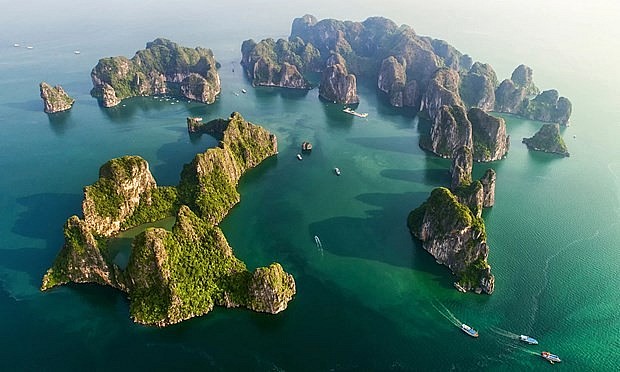 |
| Ha Long Bay. Photo: Wanderlust |
Packed with wild parks, natural wonders, and ancient temples, it's fantastic that South-East Asia has just 41 UNESCO World Heritage Sites, the magazine said.
Ha Long Bay
Ha Long Bay, one of the most beautiful places in the world, was ranked first in the list.
It won UNESCO recognition in 1994 and again in 2000 as a world natural heritage for the beauty of its landscape and its geological and geomorphological values.
Located in northern Quang Ninh province, the bay is 165 kilometers from the capital city of Hanoi. It covers an area of 43,400 hectares and includes over 1,600 islands and islets, and most of the bay is uninhabited and unaffected by humans, according to UNESCO.
"Lying prostrate aboard an old wooden junker, peering out across the emerald waters as jungle-covered precipices rear out of nowhere isn’t the only way to experience Cat Ba Island’s Halong Bay – it remains among the best, though," the magazine said.
"These limestone karst pillars aren’t unique to Vietnam, but nowhere on Earth is their scale so dramatic, sprouting some 1,600 spines from the waters of the Gulf of Tonkin, birthing towering islands and islets out of bounds to all but the native seabirds that have made them home.”
 |
| Ha Long Bay, is one of the most beautiful places in the world. Photo: TITC |
"The site was first inscribed by UNESCO in 1994. Twenty-something years later, little has changed except how to see them and the increasing numbers of those who have. The slow screw of erosion has notched hidden caves and dramatic arches into many of its rises.”
"Kayak out for a more intimate look at the likes of Thien Cung, famed for its impressive stalagmites and stalactites; or drift past oysters farms and floating villages – ramshackle constructions linked by trembling walkways – to seek out secret beaches away from the boat-going hordes," the magazine wrote.
Hoi An
The ancient town of Hoi An in central Vietnam is placed sixth on the list.
"Far removed from the fogs of exhaust that envelop many a visit to Southeast Asia, UNESCO-listed Hoi An is a quiet, sculpted riposte to the pace of modern Vietnamese life," according to Wanderlust.
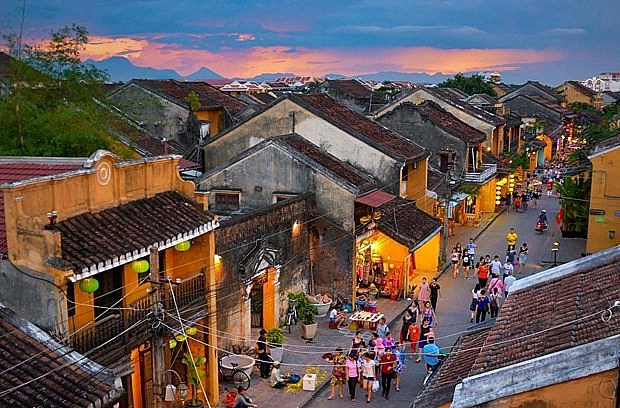 |
| The ancient town of Hoi An in central Vietnam. Photo: Wanderlust |
"It wasn’t always the case, though. The city was once a thriving port town and home to merchants from across Asia until the Thu Bon River silted up some 200 years ago and the traders moved on elsewhere.”
“Reminders of Hoi An’s multi-cultural past abound in its French-style buildings, Chinese Quarter, and dainty Japanese-style covered bridge. The Chinese influence is particularly visible in the city’s assembly halls, each built according to the home province of its settlers.”
"Traffic is banned from the center, affording the chance to gaze undisturbed at the faded pastel facades, colonnaded balconies, cafés, markets, tailors, and boutiques that cluster the Old Town. All is peace but for the ringing of temple bells and the clatter of visitors’ feet. It’s hardly a hidden escape, but it’s no wonder it's adored by so many," it said.
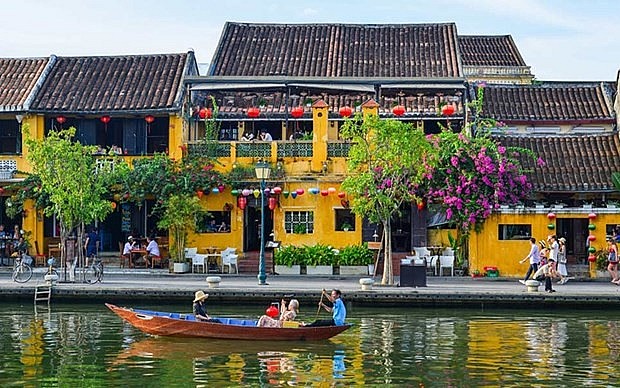 |
| A corner of the UNESCO-recognised ancient city of Hoi An. Photo: VNA |
It suggested: "Walking along this picturesque town is like stepping back in time. The city is one big playground for Instagram savvies as its colorful structures, and charming architecture offer endless snap opportunities. One of the top attractions is the Japanese Bridge, and museums await history buffs."
"Tourists can also rent bikes to get the most out of Hoi An, a place straight out of a picture book," it added.
Phong Nha-Ke Bang National Park
Phong Nha-Ke Bang National Park in the central province of Quang Binh province was inscribed in UNESCO's World Heritage List in 2003. It features great geological diversity and offers spectacular phenomena while harboring a high level of biodiversity and many endemic species.
Phong Nha is home to Son Doong, the biggest natural cave on the planet, as well as the third largest Hang En. The Blue Diamond camping site is near the historical Khe Gat Field military airport.
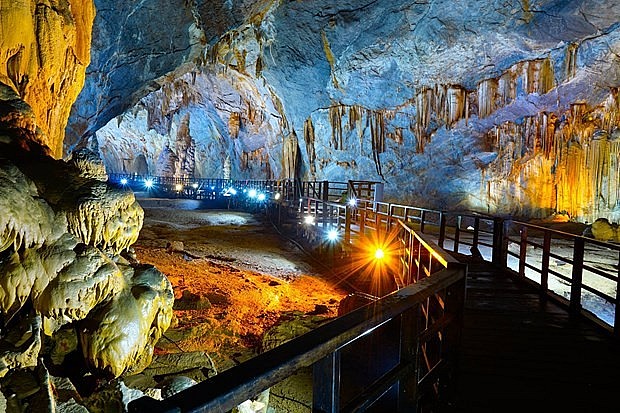 |
| Thien Duong cave. Photo: Wanderlust |
"Despite boasting 885 sq.km of untamed evergreen jungle and some of the oldest karst peaks in Asia, neither is surprisingly the main draw at Phong Nha-Ke Bang National Park. That privilege goes to the stunning caves and underground rivers that vein the land beneath," Wanderlust said.
The magazine wrote that the park was recognized by UNESCO long before Son Doong Cave, a 5 km-long cavern so big one could fit a skyscraper inside, was named the world’s largest cave. That was opened to visitors in 2013, although guided trips into its gaping limestone maw are still in their infancy. More caves are always being found, with the glistening underground stalagmite field of newly discovered Hang Va becoming the latest to receive tours.
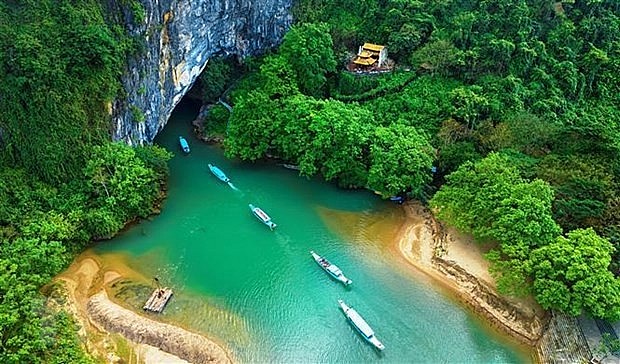 |
| The Phong Nha-Ke Bang National Park contains terrestrial and aquatic habitats. Photo: VNA |
“Far easier to get to is Paradise Cave, with buggies shepherding crowds from the nearby village of Son Trach – a good base for visiting the park. Inside, enormous stalactites bear down from a ceiling that extends for 31km but go early to beat the crowds. Alternatively, head to the Dark Cave, which requires a kayak trip upriver. Once inside, slip into its mud pool before cleaning off with a swim in an underground lake.”
The other UNESCO world heritage wonders on the list in order are Singapore Botanic Gardens (Singapore), Luang Prabang (Laos), Gunung Mulu National Park, Borneo (Malaysia), Sukhothai and Associated Historic Towns (Thailand), Temple of Preah Vihear (Cambodia), Komodo National Park (Indonesia), Tubbataha Reefs Natural Park, Palawan (Philippines), Rice Terraces of the Philippine Cordilleras (Philippines), Kinabalu National Park, Borneo (Malaysia), Tropical rainforest heritage of Sumatra (Indonesia), Angkor archaeological park (Cambodia), Thungyai-Huai Kha Khaeng wildlife sanctuaries (Thailand), and Borobudur temple compounds (Indonesia)./.
 | Cham People’s Pottery Making Art Named UNESCO Heritage in Need of Urgent Safeguarding The art of pottery making of Cham ethnic people was inscribed in the list of intangible cultural heritage in need of urgent safeguarding by UNESCO ... |
 | Vietnamese Driftwood Sculpture Artworks to Exhibit in Germany Le Ngoc Thuan, a Vietnamese artist breathes new life into driftwood with artisans from Kim Bong Carpentry Village in Hoi An City, Quang Nam Province, ... |
 | UNESCO Accompanies Hanoi in Protecting Cultural Heritage Vice Chairman of Hanoi People's Committee Vu Thu Ha on July 5 had a meeting with Firmin Edouard Matoko, Assistant Director-general of the Africa Department ... |
Recommended
 Travel
Travel
Vietnam Through Australian Eyes: Land of Flavor, Warmth, and Timeless Charm
 Travel
Travel
Strategies for Sustainable Growth of Vietnam’s Tourism from International Markets
 Travel
Travel
Vietnam Strengthens Its Presence On The Global Tourism Map
 Multimedia
Multimedia
Phong Nha-Ke Bang National Park Named Top Adventure Travel Site
 Travel
Travel
Vietnam Welcomes Record-High Number of International Visitors
 Travel
Travel
Luxury Train From Hanoi To Hai Phong To Be Launched In May
 Travel
Travel
Phong Nha Named Top Budget-Friendly Travel Destination for Spring 2025: Agoda
 Travel
Travel


